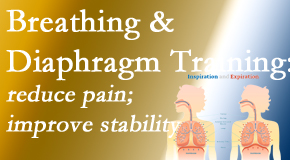Williamson Spine Stability Helped by Breathing and Diaphragm Training
Spinal stability is the foundation for spine movement. Spinal stability safeguards the nervous system structures, the spinal cord, and spinal nerve roots. Apple Country Chiropractic assesses spinal stability in all our Williamson back pain patients as part of our chiropractic service. Spinal stability relies on strong, stable musculature to do its job. New research is indicating that the role of the diaphragm and breathing is to support spinal stability.
SPINAL STABILITY
All the assorted parts of the spine contribute to spinal stability, even the slightest spinal motion segment’s vertebra (the bony part of the spine). Ligaments, bones, and discs in the spine supply all sorts of coupled motions of the spine and transfer proprioceptive impulses to the central nervous system which aligns muscle tone, movement, and reflexes. If any of the spinal structures are injured or otherwise in peril – like a degenerated disc – spinal instability is feasible. (1) That’s where your Williamson chiropractor comes into play with chiropractic spinal manipulation and an effective treatment plan including exercise.
BREATHING TRAINING IN SPINAL STABILITY
Chiropractic care at Apple Country Chiropractic addresses spinal stability with some common exercise suggestions and looks at the use of newer exercise methods like breathing that appear promising. Maximal abdominal contraction maneuver compared with maximal expiration exercise proved itself better at increasing spinal stability. As a breathing exercise to enhance spinal joint stability, it had a beneficial effect on increasing co-contraction and spine stability as shown by significantly larger muscle thickness of the transverse abdominis and rectus abdominis. (2) Forced breathing exercise therapy improved trunk stability and activities of daily living in chronic low back pain patients. (3) Williamson back pain patients will value how something they do every day – performed with just a bit more intention - may ease their back pain!
DIAPHRAGM TRAINING IN SPINAL STABILITY
Certainly, breathing and the diaphragm are intimately connected, and both offer some hope in fixing spinal stability issues. Apple Country Chiropractic found some new studies on how diaphragm training addresses spinal stability. In a study of rehabilitating athletes with nonspecific low back pain, inserting diaphragm training (breathing) to electrical stimulation therapy was beneficial in improving function, stability, pain, and balance. (4) Diaphragm training significantly reduced the severity of pain and also affected the thickness of active stabilizers - transversus abdominis, lumbar multifidus muscle - in the lumbar spine. (5) Strong, thick spinal stabilizers are helpful in managing Williamson back pain.
CONTACT Apple Country Chiropractic
Listen to this PODCAST with Dr. Lee Hazen and Cheri Hazen RN, ICHC, FNLP, LE, on The Back Doctors Podcast with Dr. Michael Johnson as they share their combined treatment approach of breathing training and the Cox® Technic System of Spinal Pain Management helped a patient find back pain relief.
Set up your Williamson chiropractic appointment now. Breathing and diaphragm training go a long way in keeping the spine stable, decreasing Williamson back pain, and maintaining the foundation of spinal movement intact.

